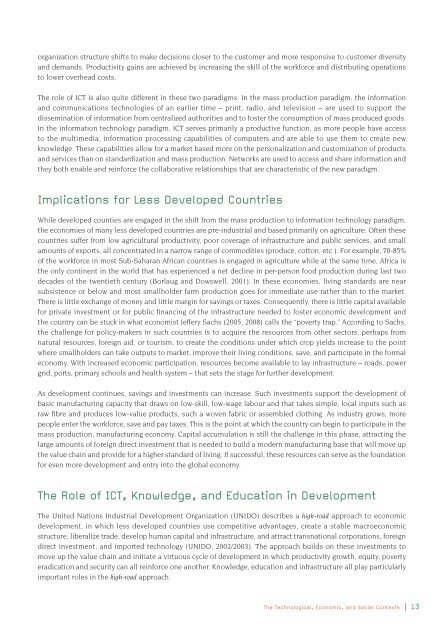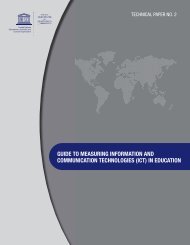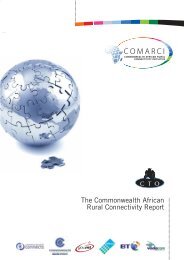Transforming education: the power of ICT policies - Commonwealth ...
Transforming education: the power of ICT policies - Commonwealth ...
Transforming education: the power of ICT policies - Commonwealth ...
You also want an ePaper? Increase the reach of your titles
YUMPU automatically turns print PDFs into web optimized ePapers that Google loves.
organization structure shifts to make decisions closer to <strong>the</strong> customer and more responsive to customer diversity<br />
and demands. Productivity gains are achieved by increasing <strong>the</strong> skill <strong>of</strong> <strong>the</strong> workforce and distributing operations<br />
to lower overhead costs.<br />
The role <strong>of</strong> <strong>ICT</strong> is also quite different in <strong>the</strong>se two paradigms. In <strong>the</strong> mass production paradigm, <strong>the</strong> information<br />
and communications technologies <strong>of</strong> an earlier time – print, radio, and television – are used to support <strong>the</strong><br />
dissemination <strong>of</strong> information from centralized authorities and to foster <strong>the</strong> consumption <strong>of</strong> mass produced goods.<br />
In <strong>the</strong> information technology paradigm, <strong>ICT</strong> serves primarily a productive function, as more people have access<br />
to <strong>the</strong> multimedia, information processing capabilities <strong>of</strong> computers and are able to use <strong>the</strong>m to create new<br />
knowledge. These capabilities allow for a market based more on <strong>the</strong> personalization and customization <strong>of</strong> products<br />
and services than on standardization and mass production. Networks are used to access and share information and<br />
<strong>the</strong>y both enable and reinforce <strong>the</strong> collaborative relationships that are characteristic <strong>of</strong> <strong>the</strong> new paradigm.<br />
Implications for Less Developed Countries<br />
While developed counties are engaged in <strong>the</strong> shift from <strong>the</strong> mass production to information technology paradigm,<br />
<strong>the</strong> economies <strong>of</strong> many less developed countries are pre-industrial and based primarily on agriculture. Often <strong>the</strong>se<br />
countries suffer from low agricultural productivity, poor coverage <strong>of</strong> infrastructure and public services, and small<br />
amounts <strong>of</strong> exports, all concentrated in a narrow range <strong>of</strong> commodities (produce, cotton, etc.). For example, 70-85%<br />
<strong>of</strong> <strong>the</strong> workforce in most Sub-Saharan African countries is engaged in agriculture while at <strong>the</strong> same time, Africa is<br />
<strong>the</strong> only continent in <strong>the</strong> world that has experienced a net decline in per-person food production during last two<br />
decades <strong>of</strong> <strong>the</strong> twentieth century (Borlaug and Dowswell, 2001). In <strong>the</strong>se economies, living standards are near<br />
subsistence or below and most smallholder farm production goes for immediate use ra<strong>the</strong>r than to <strong>the</strong> market.<br />
There is little exchange <strong>of</strong> money and little margin for savings or taxes. Consequently, <strong>the</strong>re is little capital available<br />
for private investment or for public fi nancing <strong>of</strong> <strong>the</strong> infrastructure needed to foster economic development and<br />
<strong>the</strong> country can be stuck in what economist Jeffery Sachs (2005, 2008) calls <strong>the</strong> “poverty trap.” According to Sachs,<br />
<strong>the</strong> challenge for policy-makers in such countries is to acquire <strong>the</strong> resources from o<strong>the</strong>r sectors, perhaps from<br />
natural resources, foreign aid, or tourism, to create <strong>the</strong> conditions under which crop yields increase to <strong>the</strong> point<br />
where smallholders can take outputs to market, improve <strong>the</strong>ir living conditions, save, and participate in <strong>the</strong> formal<br />
economy. With increased economic participation, resources become available to lay infrastructure – roads, <strong>power</strong><br />
grid, ports, primary schools and health system – that sets <strong>the</strong> stage for fur<strong>the</strong>r development.<br />
As development continues, savings and investments can increase. Such investments support <strong>the</strong> development <strong>of</strong><br />
basic manufacturing capacity that draws on low-skill, low-wage labour and that takes simple, local inputs such as<br />
raw fi bre and produces low-value products, such a woven fabric or assembled clothing. As industry grows, more<br />
people enter <strong>the</strong> workforce, save and pay taxes. This is <strong>the</strong> point at which <strong>the</strong> country can begin to participate in <strong>the</strong><br />
mass production, manufacturing economy. Capital accumulation is still <strong>the</strong> challenge in this phase, attracting <strong>the</strong><br />
large amounts <strong>of</strong> foreign direct investment that is needed to build a modern manufacturing base that will move up<br />
<strong>the</strong> value chain and provide for a higher standard <strong>of</strong> living. If successful, <strong>the</strong>se resources can serve as <strong>the</strong> foundation<br />
for even more development and entry into <strong>the</strong> global economy.<br />
The Role <strong>of</strong> <strong>ICT</strong>, Knowledge, and Education in Development<br />
The United Nations Industrial Development Organization (UNIDO) describes a high-road approach to economic<br />
development, in which less developed countries use competitive advantages, create a stable macroeconomic<br />
structure, liberalize trade, develop human capital and infrastructure, and attract transnational corporations, foreign<br />
direct investment, and imported technology (UNIDO, 2002/2003). The approach builds on <strong>the</strong>se investments to<br />
move up <strong>the</strong> value chain and initiate a virtuous cycle <strong>of</strong> development in which productivity growth, equity, poverty<br />
eradication and security can all reinforce one ano<strong>the</strong>r. Knowledge, <strong>education</strong> and infrastructure all play particularly<br />
important roles in <strong>the</strong> high-road approach.<br />
The Technological, Economic, and Social Contexts | 13
















